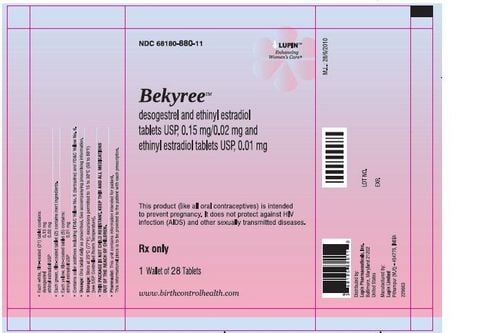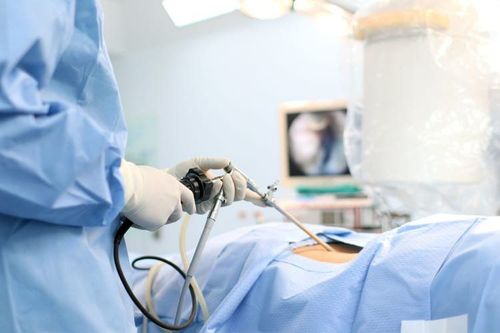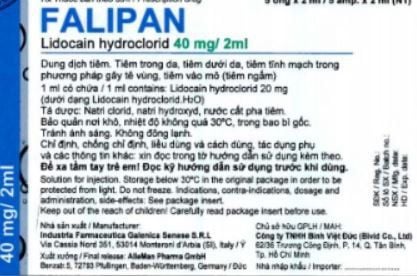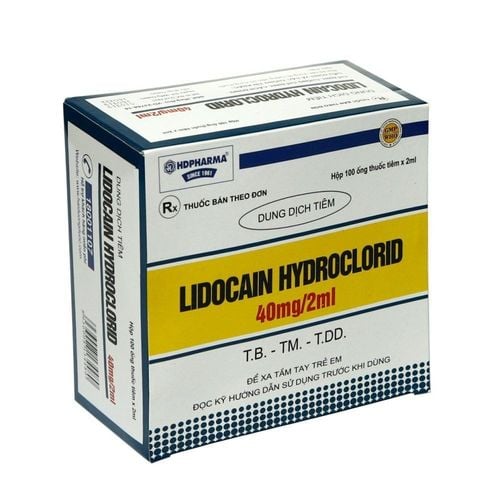This is an automatically translated article.
The article was professionally consulted by an Anesthesiologist - General Surgery Department - Vinmec Nha Trang International General Hospital.Ovarian cystectomy is an effective and thorough treatment for ovarian cysts. Spinal anesthesia is one of the techniques that can be used to anesthetize an ovarian cyst.
1. Ovarian cyst removal surgery
Ovarian cysts are very common tumors in women, especially women of reproductive age. Ovarian cysts come in many different forms and can develop from the tissues of the ovaries or from other tissues in the body. Tumors often grow silently for many years, without obvious symptoms. However, if not detected and treated promptly, ovarian cysts can cause many complications that seriously affect the patient's health. The tumor may grow larger and larger, compressing neighboring organs causing symptoms such as pain in the lower abdomen, urinary retention, defecation disorders, ascites,...The tumor may also be twisted or broken, This is a life-threatening emergency that requires immediate surgery. In addition, there is a large proportion of ovarian tumors that are malignant (about 15%), if not diagnosed and treated early, the cancer will grow more and more severe.
Ovarian cyst removal surgery will be indicated surgery in the following cases:
The patient has cysts on both ovaries; Cysts do not go away by themselves, getting bigger and bigger after 2-3 months of follow-up; Cysts are larger than 7.6cm but if determined to be a physical tumor, surgery will be indicated, regardless of size; Ultrasound showed that the cyst was not a functional cyst or could not be classified as a functional cyst or an organic cyst; The doctor evaluates the cyst as potentially malignant; Cysts in women who no longer want to have children or cysts in postmenopausal women. Ovarian cystectomy is an effective and thorough treatment for ovarian cysts. There are two surgical methods to remove ovarian cysts, namely open surgery and laparoscopic surgery. The choice of surgical method depends on the nature of the tumor. Laparoscopic surgery is often applied in cases where the tumor is less than 10cm in size, not malignant.
Anesthesia is a very important step in any surgery. Effective and successful analgesia is a premise for the surgery to go smoothly. Spinal anesthesia is an anesthetic technique that can be used to anesthetize surgically removing ovarian cysts. This is a technique of anesthesia by injecting local anesthetic into the subarachnoid space to temporarily inhibit nerve conduction through the spinal cord to meet the requirements of anesthesia for surgery and analgesia.
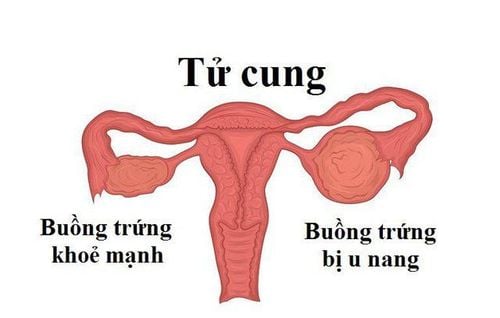
U nang buồng trứng phát triển âm thầm
2. Technique of spinal anesthesia for ovarian cyst removal surgery
2.1. Point
Spinal anesthesia may be indicated as an anesthetic method for surgical removal of ovarian cysts and for postoperative analgesia.Spinal anesthesia is not performed in the following cases:
The patient refuses to perform the method; The patient is allergic to the anesthetic or has an infection in the area where the needle is injected; Patients with lack of circulating volume, shock; severe coagulopathy or inadequately discontinuing anticoagulants. Patients with constricted mitral stenosis, constricted aortic valve or increased intracranial pressure.
2.2. Preparing to perform spinal anesthesia in ovarian cyst removal surgery
About peopleSpinal anesthesia will be performed by doctors, nurses specializing in anesthesiology.
About means and tools
Necessary means and tools for anesthesia and anesthetics include:
Syringes and needles of all sizes, gloves, sterile gauze, pince, antiseptic alcohol, sterile hole towels, anesthetic needles spinal anesthesia of all sizes. Local anesthetics: bupivacaine, levobupivacaine, ropivacaine,... can be combined with morphine drugs (morphine from 100-300mcg; fentanyl 25-50 mcg; sulfentanil 2.5-5mcg,...) In addition, to ensure safety During anesthesia and surgical procedures, there is a need for means of resuscitation, circulatory resuscitation drugs and anticonvulsants (such as barbituric, benzodiazepines, muscle relaxants, 10-20% intralipid, etc.). .).
On the patient's side
To prepare for spinal anesthesia, the doctor will examine before surgery, explain to the patient to cooperate when performing. The anesthetic area will be kept clean. The doctor will give the patient a sedative from the night before surgery if necessary.

Bệnh nhân có thể được sử dụng thêm thuốc an thần trước phẫu thuật
2.3. Steps to perform spinal anesthesia for ovarian cyst removal surgery
To prevent hypotension, patients will be placed intravenous lines, fluid resuscitation at a dose of 5-10ml/kg (for adults). There are two positions commonly used for spinal anesthesia, which are:Sitting position: the patient sits with his back bent, head bowed, chin resting on chest, legs stretched on the operating table or feet resting on a chair. Lying position: the patient lies on his side, with his back arched, knees close to his stomach, chin resting on his chest. Steps of spinal anesthesia to surgically remove ovarian cysts include:
Anesthesiologists and resuscitators wear hats, masks, wash hands, wear clothes, and wear sterile gloves. Disinfect the puncture site three times with an antiseptic solution, then cover with a sterile tissue. Anesthesia may be applied to the midline or lateral line. If the anesthetic is in the midline, the doctor will insert the needle into the gap between the two vertebrae, the puncture location will depend on the high or low surgery, usually in the L3-L4 to L4-L5 positions. If anesthesia is applied to the lateral line, the doctor will conduct a needle puncture 1-2cm from the midline, directing the needle in the middle, up, and out. The doctor inserts the needle so that the bevel direction of the anesthetic needle is parallel to the patient's spine. Insert the needle until a loss of resistance is felt as the needle passes through the sclera. If CSF is present, turn the bevel of the needle towards the patient's head and inject the anesthetic. The dose of anesthetic is calculated by the doctor based on the patient's weight, height and physical condition: bupivacaine dose is from 8-15mg, levobupivacaine 8-15mg. ropivacaine dose from 10-15mg,...
To relieve pain after surgery for ovarian cyst, conduct continuous infusion through epidural catheter (if using CSE method) bupivacaine 0.1 - 0.125 speed run from 4-6ml/hour, ropivacaine 0.08 - 0.125 rate 4-10ml/hour; levobupivacaine 0.125 rate 4-10ml/hour. Concentrations of combination drugs that can be used are: morphine 10-20mcg/ml; fentanyl 1-2mcg/ml; sufentanil 0.5 mcg/ml.
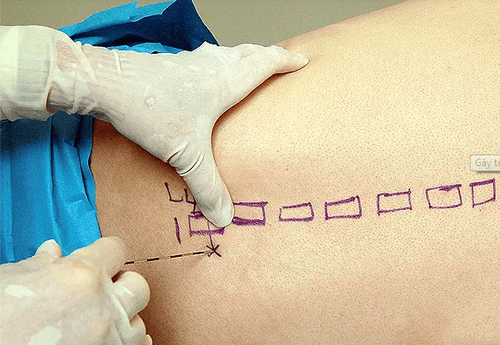
Khi thực hiện phẫu thuật, có thể gây tê vào đường giữa hoặc đường bên tủy sống
3. Possible complications during spinal anesthesia to surgically remove ovarian cysts and how to handle them
3.1. Drug-induced complications and treatment
New generation anesthetics have high safety, allergic reactions, anaphylaxis rarely occur. However, if the patient shows signs of anaphylaxis, the doctor will immediately stop the drug and start an anti-anaphylactic regimen. If the patient is poisoned by local anesthetic due to the wrong injection of anesthetic into the blood vessel, causing poisoning, the doctor will immediately stop the anesthetic, use anticonvulsant drugs, neutralize the effect of the anesthetic, and perform emergency resuscitation. respiration, circulation...3.2. Complications due to spinal anesthesia technique and how to manage
Low blood pressure, slow pulse The doctor will give the patient a vasopressor (ephedrine, adrenaline,...), atropin and fluid rehydration.Headache Use a pencil needle to limit the drainage of cerebrospinal fluid.
If the patient has a headache, the doctor will instruct the patient to lie down, get enough fluids, use pain relievers, and patch the dura with autologous blood (Blood Patch) when other measures are not effective.
Nausea and vomiting Strictly control the patient's blood pressure and give antiemetics.
Urinary retention The doctor will prescribe warm compresses and bladder catheterization if necessary.
General spinal anesthesia If the patient has symptoms of general spinal anesthesia, the entire anesthetic and surgical team will actively perform respiratory and circulatory resuscitation.
In addition, other complications of spinal anesthesia may be encountered are hematoma around the spinal cord, spinal cord injury, ponytail syndrome, meningitis,... Depending on the situation, the doctor will conduct consultation and exploration to have appropriate treatment.

Bí tiểu là một tai biến sau khi gây tê tủy sống
Currently, Vinmec International General Hospital offers a basic gynecological examination and screening package, helping customers to detect early infectious diseases for easy and inexpensive treatment. Screening for early detection of gynecological cancer (cervical cancer) for female customers even if there are no symptoms or may have the following symptoms:
Female customers have several factors Risks such as poor personal hygiene, unsafe sex, abortion, ... Female customers have other symptoms such as: abnormal vaginal discharge, itching, pain in the intimate area, vaginal bleeding abnormal. Abnormal vaginal bleeding Menstrual problems: irregular periods, irregular periods Abnormal vaginal discharge (smell, different color) Pain, itching in the vaginal area
Please dial HOTLINE for more information or register for an appointment HERE. Download MyVinmec app to make appointments faster and to manage your bookings easily.




